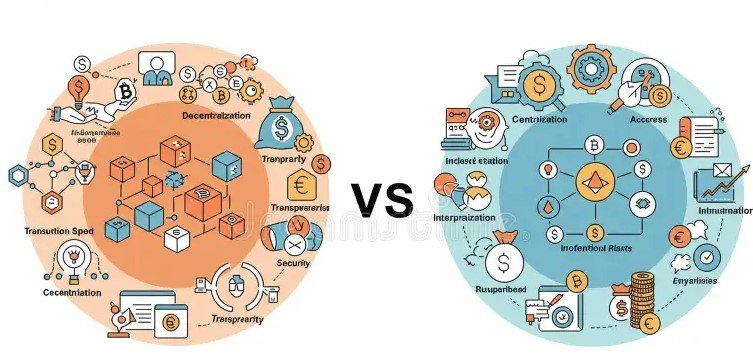In 2025, more people face choices between traditional banks with physical branches and online banks that operate fully digitally. This shift comes as interest rates climb and technology changes how we handle money, pushing many to compare options for better savings and convenience.
Physical Presence and Branch Access
Traditional banks rely on networks of physical locations where customers can walk in for services. These spots allow direct talks with staff for tasks like depositing cash or getting advice on loans.
Online banks skip branches altogether and focus on apps and websites. This setup suits busy folks who prefer handling everything from their phones. Yet, it can frustrate those needing to deposit large cash amounts or who value face-to-face help.

Recent data shows traditional banks still hold about 70 percent of customer accounts worldwide, but online options grow fast in urban areas. People in rural spots often stick with local branches for easy access.
Without physical sites, online banks cut costs and pass savings to users through perks. This difference matters most for travelers or remote workers who rarely visit a branch.
Fees, Interest Rates, and Savings Potential
Fees add up quickly in banking, and traditional banks often charge for monthly maintenance, overdrafts, and ATM use outside their network. These costs can eat into savings over time.
Online banks shine here with lower or no fees due to reduced overhead. Many offer free checking and high-yield savings accounts that beat traditional rates.
For example, in 2025, online savings accounts average around 4 percent APY, while traditional ones hover at 0.5 percent or less. This gap helps savers build wealth faster amid rising inflation.
- Lower fees on transactions and accounts
- Higher interest on deposits
- No charges for basic services like transfers
Traditional banks sometimes waive fees for high-balance customers, but online rivals make it easier for everyone. This makes online options appealing for budget-conscious users.
Experts note that switching banks remains low, with only about 2 percent of global consumers changing in 2025. Still, those who do often cite fees as the main reason.
Customer Service and Support Options
Traditional banks provide in-person support during business hours, which builds trust through direct interactions. Customers can resolve complex issues quickly with a teller or manager.
Online banks use chatbots, phone lines, and apps for 24/7 help. This works well for quick questions but may lack the personal touch for tricky problems.
Many users report faster responses from online support, especially at night or on weekends. Traditional banks adapt by adding digital tools, yet they often close early.
A recent survey found 60 percent of people prefer hybrid service, blending online ease with occasional branch visits. This trend pushes banks to offer both.
In 2025, complaints about wait times drop for online banks thanks to AI improvements. Traditional ones invest in apps to keep up, but some customers miss the human element.
Technology and Innovation Features
Online banks lead in tech with user-friendly apps for budgeting, instant transfers, and real-time alerts. They integrate tools like AI advisors for personalized tips.
Traditional banks catch up by updating their systems, but they move slower due to legacy setups. Many now offer mobile banking, yet it feels less seamless.
Innovation drives growth, with online banks adding features like crypto links or automated savings. This attracts younger users who expect tech-savvy services.
| Feature | Traditional Banks | Online Banks |
|---|---|---|
| App Usability | Good, but varies by bank | Excellent, mobile-first design |
| 24/7 Access | Limited to business hours | Full access anytime |
| Advanced Tools | Basic budgeting | AI-driven insights and automation |
| Integration | Slower updates | Quick adoption of new tech |
This table highlights how online banks push boundaries, while traditional ones focus on stability. As 2025 unfolds, expect more AI and real-time payments in both.
Security Measures and Risk Factors
Both types of banks use strong security like encryption and fraud monitoring. Traditional banks add physical safeguards at branches to prevent theft.
Online banks face more cyber threats but counter with advanced tools like biometric logins. They often reimburse fraud losses quickly.
Data from 2025 shows cyber attacks rise, yet online banks report fewer successful breaches due to constant updates. Traditional banks deal with physical risks like robberies, though rare.
Customers worry about data privacy in digital banking. Regulators push stricter rules, ensuring all banks meet high standards.
To stay safe, users should enable two-factor authentication and monitor accounts regularly. Both options prove secure when handled wisely.
Loan and Financial Product Availability
Traditional banks offer a wide range of loans with in-person approvals, which can speed up processes for big purchases like homes.
Online banks streamline applications through apps, often with faster decisions based on algorithms. They may lack options for complex needs like business loans.
In 2025, online lenders approve loans in days, compared to weeks at traditional spots. This helps for quick needs like personal loans.
Rates vary, but online banks sometimes offer better deals due to competition. Traditional ones provide more guidance for first-time borrowers.
Choosing the Best Bank for Your Needs
Decide based on your lifestyle: opt for traditional if you value personal service, or online for convenience and savings.
Hybrid models gain popularity in 2025, blending both worlds. Research options to match your goals, like high interest for savers or branches for cash handling.
Weigh pros and cons carefully. Many find combining accounts from both types works best.
Share your banking experiences in the comments below, and pass this article to friends facing the same choice. Your input could help others decide.








